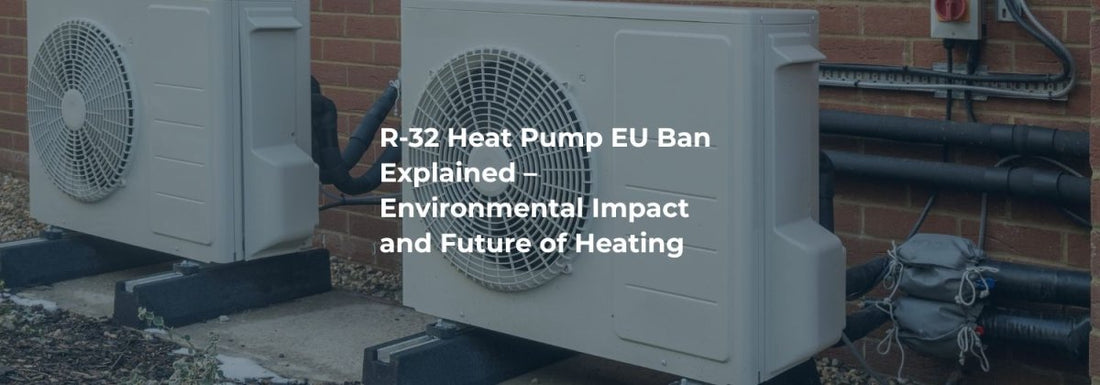
R-32 Heat Pump Ban Explained: Environmental Impact and the Future of Heating
R-32 Heat Pumps and the EU 2027 Ban: The Hidden Environmental Cost of “Green” Heating
Are heat pumps really as clean as we think?
Heat pumps have become the symbol of Europe’s low-carbon revolution. They’re promoted as efficient, renewable, and eco-friendly — a cornerstone of the journey away from gas boilers.
But hidden inside every heat pump is a problem that rarely gets discussed: the refrigerant gas.
Most modern heat pumps use R-32 (difluoromethane) — a synthetic gas that makes the system work efficiently but carries a heavy environmental footprint.
Even though R-32 replaced older refrigerants like R-410A, its Global Warming Potential (GWP) is still around 675. That means just one kilogram of R-32 released into the atmosphere has the same climate impact as 675 kilograms of CO₂ — roughly the same as driving a petrol car from London to Barcelona.
Multiply that by millions of systems installed across Europe, and the environmental cost becomes impossible to ignore.
The EU F-Gas Regulation: Why R-32 is being phased out
In 2024, the European Union approved a major revision to its F-Gas Regulation, tightening restrictions on high-GWP refrigerants in heating and cooling equipment.
| Year | System Type | Max GWP Allowed | R-32 Status |
|---|---|---|---|
| 2025 | Split systems with < 3 kg charge | 750 | ✅ Allowed |
| 2027 | Split heat pumps ≤ 12 kW | 150 | ❌ Banned |
| 2029 | Split systems > 12 kW | 750 | ✅ Allowed temporarily |
From 1 January 2027, any new split heat pump up to 12 kW sold in the EU must use a refrigerant with a GWP below 150, effectively ending the use of R-32 in most residential systems. The goal is simple — to cut thousands of tonnes of fluorinated gas emissions that undermine Europe’s climate targets.
Will the UK follow the EU ban on R-32?
Although the UK has not yet confirmed identical restrictions, the Environment Agency and DEFRA are reviewing the domestic F-Gas framework.
Given the UK’s net-zero targets and reliance on EU product standards, most experts agree that R-32 will be phased out by the end of the decade.
For now, only the 2025 limit applies, meaning R-32 systems are still legal in Great Britain — but the direction is inevitable.
Manufacturers are already redesigning their product lines for low-GWP or natural refrigerants to stay compliant.
The hidden costs of refrigerant-based heating
- Manufacturing footprint: Fluorinated refrigerants are energy-intensive to produce and rely on complex chemical supply chains.
- End-of-life emissions: Residual gases can escape during servicing or disposal without rigorous recovery.
- Lifetime leakage: Many systems lose part of their charge over 10–15 years, directly adding to greenhouse gas emissions.
- Recycling challenges: Refrigerants are difficult to reclaim and reuse, creating long-term liabilities.
And then there’s the maintenance reality.
While the technology itself sounds simple, heat pumps are not maintenance-free. Over time, users often face:
- Refrigerant leaks that require recharging and specialist service visits,
- Compressor wear that increases noise and energy use,
- Corrosion of coils and fittings, especially in outdoor units exposed to weather,
- Performance drops that slowly drive up running costs year after year.
Many homeowners are beginning to notice that the “low-cost” operation they were promised can turn into a familiar pattern — maintenance contracts, call-outs, and repair bills reminiscent of traditional gas or oil heating.
A smarter path: infrared heating with zero refrigerants
At iHelios Living Reinvented, we’ve eliminated refrigerants entirely.
Our infrared heating film delivers silent, efficient, and comfortable warmth without compressors, refrigerant gases, or outdoor units. It uses electricity directly to heat surfaces and people — not the air — and can be fully powered by solar and home battery storage.
- 🌿 No refrigerants — zero risk of leaks or chemical emissions.
- ⚡ Up to 99% efficiency — electricity converted straight into radiant heat.
- 🏡 Low maintenance — no moving parts, filters, or fluids.
- 🔋 Smart energy integration — works with iHelios controls & storage for automation and off-peak optimisation.
The future is electric — and refrigerant-free
R-32 was an important step in the evolution of heat pump technology, but it’s not where the journey ends. As the EU — and likely the UK — move toward stricter environmental regulation, infrared heating stands out as the cleanest, simplest, and most future-proof solution available today.
No refrigerants. No leaks. No compromises.
Source: https://eur-lex.europa.eu/legal-content/EN/TXT/PDF/?uri=OJ%3AL_202400573
